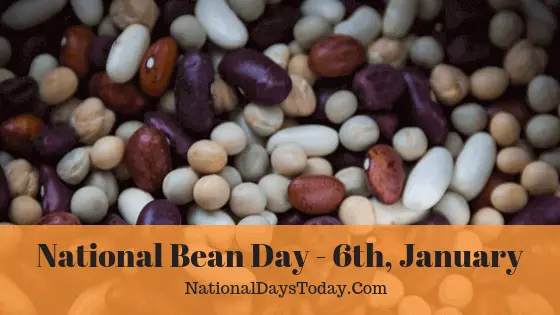National Bean Day
National Bean Day:
Celebrated on January 6th, every year. The day is to recognize the health benefits of all varieties of Bean.
| Year | Date | Day | Where |
| 2022 | 6th January | Friday | United States |
| 2023 | 6th January | Saturday | United States |
| 2023 | 6th January | Sunday | United States |
Twitter Hashtags:
#BeanDay
#NationalBeanDay
Related: Other National Days Celebrated on January 6th:
Why Bean Day?
January 6 recognizes all forms of Beans and its abundant health benefits that made it an imperative food. A bean is actually a seed that belongs to one of flowering plant family called Fabaceae .beans are used as a human or animal food and are a great source of protein. Beans have high nutritional value that includes iron, protein, carbohydrates and folate. In addition, it have soluble fiber that helps in lowering cholesterol level in blood.
Let us thank nature and our ancestors on this day for providing such a great protein packed beans.
How we can Celebrate National Bean Day:
use this hashtag #NationalBeanDay to post on the social media regarding the varieties of Bean and its health benefits. I have mentioned few, out of the reported 40000 varieties in the interesting facts section. You reveal more and post it using this hashtag or else in the comment column.
Interesting Facts About National Bean Day:
The word “bean” is derived from the word “Bohne” of German language. In some term, all seeds are denoted as beans.
There are around 40000 varieties. However, only few are recommended for human consumption. One of the most famous bean varieties is Arachis hypogaea (peanut or groundnut).
Other consumed beans are Soybean or Soya Bean , Yellow Snap Bean or Wax Bean , Asparagus Bean or Chinese Long Bean ,Winged Bean ,White Bean , Azuki Bean or Adzuki Bean(climbing bean), Pole Bean , Flageolet, Black Bean or Turtle Bean, Purple Snap Bean ,Fava Bean or Broad Bean ,Bush Bean, Dry and Horticultural Beans ,Butterbean or Sieva, Civet or Seewee Bean, Red Bean, Scarlet Runner Bean, Mung Bean or Green Gram , Snap Bean ,Haricot Vert ,Cranberry Bean, Navy Bean ,Chick pea or Garbanzo Bean, Lentil ,Haricot Bean ,Lima Bean or Butter Bean, Pinto Beans ,Great Northern Bean, Green bean and Kidney Bean or Cannellini Bean,etc.
Half-cooked beans may be toxic than raw beans. Moreover, fermentation process is being carried out to remove toxic substances in the beans.
Bacteria can easily contaminate Beansprouts eventually resulting in various diseases.
Most varieties of beans contains a sugar molecule called oligosaccharides which a human body cannot digest,perhaps,it needs a special anti-oligosaccharide enzyme for digestion. Therefore, beans are recommended to be cooked along with herbs like cumin seeds or anise seeds or coriander seeds.
United Nation Food and Agriculture Organization categorized legumes as three main categories namely dry pulses, Oil crops and fresh vegetables. Dry pulses includes all dry and matured seeds of leguminous plants excluding soybeans and groundnuts .Oil Crops includes groundnuts and soybeans. All immature fruits of leguminous plants comes under fresh vegetable category.
Top produce of pulses is India, contributing around 21 percent of the World’s production followed by Canada covering 10 percent of the Global production. The other notable producers are Russia, China, Myanmar, Brazil, Nigeria, Ethiopia, United States, and Australia in which the United States constitutes around 3 percent.
In terms of Dry beans production, Myanmar hit the list by producing around 3800000 tonnes per year as of 2013.India ranks second with the production of around 3650000 tonnes. The other important producers are China, Brazil, Mexico, Tanzania, Unites States, Kenya, Uganda, Rwanda, etc.
History of National Bean Day:
The creator of National Bean Day and its history is unknown.


